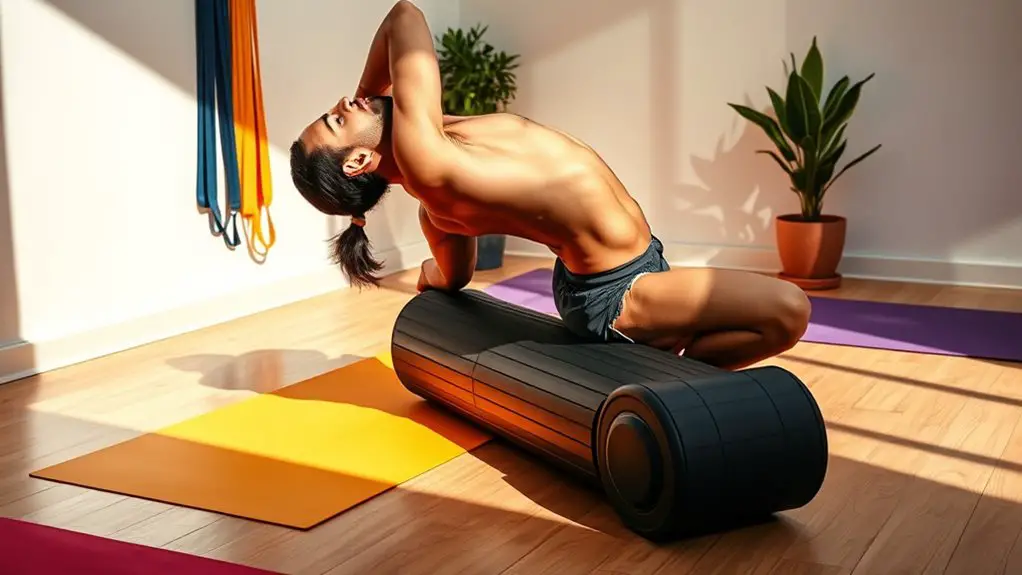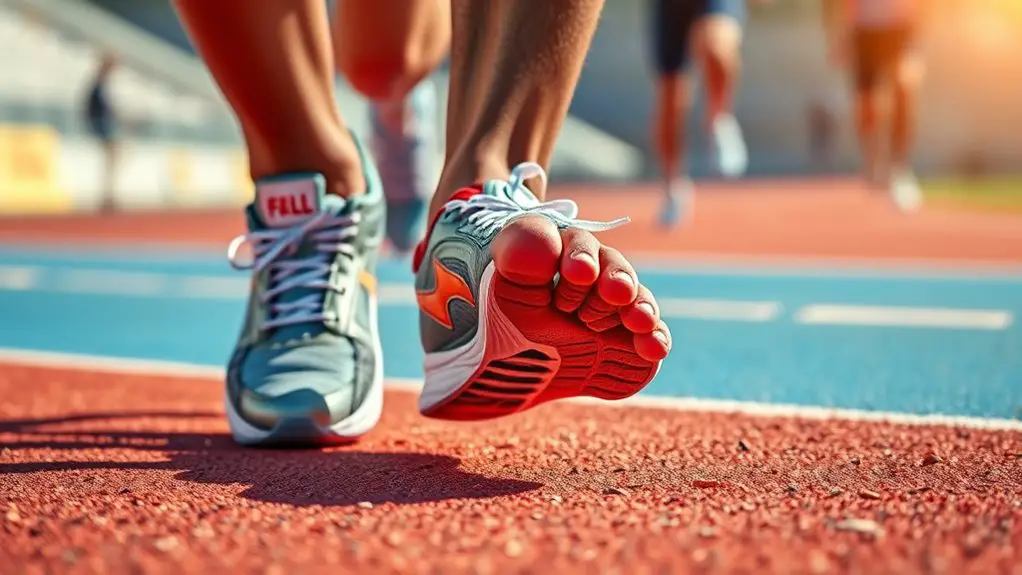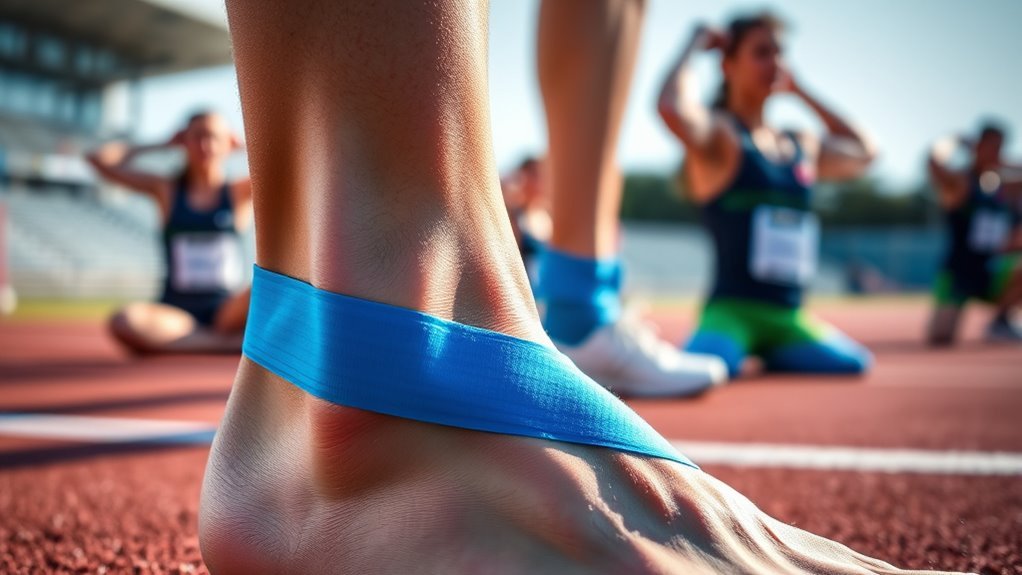To optimize muscle recovery through foam rolling, start by focusing on major muscle groups like quads, hamstrings, and back. Use your body weight to apply pressure, rolling slowly to release tension. Spend 1-2 minutes on each area, paying extra attention to tight spots. Always listen to your body; avoid rolling over joints or bony areas. Remember to integrate this into your post-workout routine for the best results. There's more to learn about advanced techniques for deeper recovery.
Understanding Foam Rolling and Its Benefits
When you're looking to enhance muscle recovery, foam rolling can be a game changer. This simple yet powerful technique helps relieve tension in your muscles, improving flexibility and reducing soreness. By using a foam roller, you're effectively performing self-myofascial release, which breaks up knots and promotes blood flow. Imagine feeling more liberated in your movements, whether you're hitting the gym or enjoying your favorite activities. Foam rolling doesn't just speed up recovery; it can also enhance your overall performance. By incorporating this practice into your routine, you'll find yourself experiencing less discomfort and more freedom to push your limits. Embrace foam rolling, and give your body the care it deserves to thrive.
Essential Foam Rolling Techniques for Beginners
Foam rolling can seem intimidating at first, but getting started with a few simple techniques can make a world of difference in your recovery routine. Begin by positioning the foam roller under your target area, like your calves or thighs. Slowly roll back and forth, letting your body weight press into the roller. Focus on areas that feel tight, spending extra time on those spots. You don't need to rush; let your breath guide your movements. Try to incorporate 1-2 minutes on each muscle group, ensuring you stay relaxed. Remember, it's about finding what feels good for you. With practice, you'll gain confidence, and foam rolling will become an essential tool in your journey to freedom in movement and recovery.
Targeting Specific Muscle Groups
While foam rolling can benefit your entire body, targeting specific muscle groups can enhance your recovery even more. Focus on areas that feel tight or sore, like your calves, quads, or back. For your calves, roll from your ankle to your knee, adjusting your body angle to hit different spots. When working on your quads, lie face down and roll from your hips to your knees, pausing on any knots you find. Don't forget your upper back; place the foam roller under it and gently roll side to side. By concentrating on these areas, you'll release tension, improve flexibility, and promote blood flow. Embrace the freedom of movement that comes from proper muscle recovery and feel your body thrive.
Foam Rolling for Post-Workout Recovery
After targeting specific muscle groups, incorporating foam rolling into your post-workout routine can greatly boost recovery. This technique helps reduce soreness and stiffness by increasing blood flow to your muscles. Just take a few minutes to roll over your major muscle groups, like quads, hamstrings, and back. You'll notice a difference in how your body feels after a tough workout.
Incorporating Foam Rolling Into Your Routine
To seamlessly integrate foam rolling into your routine, start by setting aside a few minutes each day, especially after workouts or during rest days. You don't need a strict schedule; just listen to your body and roll when it feels right. Consider placing your foam roller in a visible spot, like your living room or gym bag, as a reminder. You can even combine it with other activities, like watching TV or listening to music, making it more enjoyable. Incorporate rolling into your warm-up or cooldown sessions, targeting areas that feel tight or sore. Remember, consistency is key, so find a way to make it a natural part of your lifestyle, enhancing your recovery and overall well-being.
Common Mistakes to Avoid While Foam Rolling
When foam rolling, it's easy to make mistakes that can hinder your recovery rather than enhance it. Here are three common pitfalls to avoid:
- Rolling Too Fast: Speeding through your routine won't give your muscles the time they need to relax. Slow down and focus on each area.
- Neglecting Pain Signals: If you're feeling sharp pain, stop! Foam rolling should be uncomfortable but not unbearable. Listen to your body.
- Using Incorrect Technique: Rolling on bony areas or joints can cause injury. Always target muscle groups and avoid sensitive spots.
Advanced Foam Rolling Techniques for Serious Athletes
Avoiding common mistakes in foam rolling sets the foundation for effective recovery, but serious athletes can take their techniques to the next level. To enhance your results, try incorporating dynamic movements while rolling; this can help loosen tight muscles more effectively. Focus on specific trigger points by applying sustained pressure for 30 seconds or longer, allowing your body to release tension. You can also experiment with different foam densities to target various muscle groups. Pair foam rolling with deep breathing to improve relaxation and oxygen flow. Ultimately, consider using a partner for assisted rolling, which can provide deeper pressure and help you reach those hard-to-access spots. Embrace these advanced techniques, and you'll unleash your body's full potential.
Frequently Asked Questions
How Often Should I Foam Roll Each Week?
Think of foam rolling like tuning a guitar; consistency is key. Aim to roll at least three to four times a week. Your body craves freedom from tension, and regular practice keeps you feeling light and agile.
Can Foam Rolling Replace Stretching Exercises?
Foam rolling's great for muscle tension, but it shouldn't replace stretching. You need both for ideal flexibility and recovery. Incorporate them together to keep your body feeling free and ready for whatever you tackle next!
Is There an Optimal Duration for Foam Rolling Sessions?
Research shows that just 10 minutes of foam rolling can greatly improve muscle flexibility. You should aim for 1-2 minutes per muscle group, keeping it enjoyable and freeing, rather than a rigid routine.
What Type of Foam Roller Is Best for Beginners?
For beginners, a medium-density foam roller's best. It balances comfort and effectiveness, letting you ease into the practice. Avoid the super firm ones at first; you'll appreciate the gentler approach as you build confidence.
Can Foam Rolling Help With Injury Prevention?
Yes, foam rolling can help with injury prevention by improving flexibility and reducing muscle tightness. It encourages blood flow and prepares your muscles for activity, so you can enjoy your freedom without worrying about injuries.




